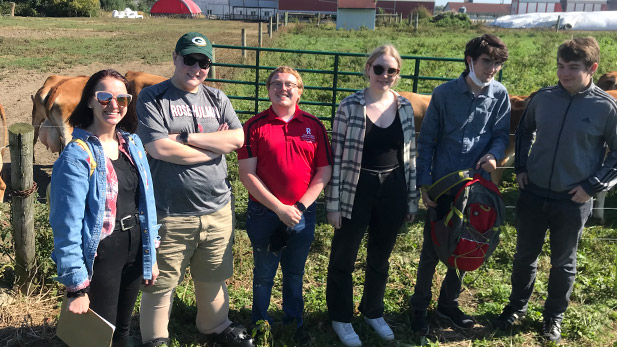Solar District Cup Runneth Over for Sustainability-Minded Students

A site visit helped the multidisciplinary senior-year design team develop a solar energy system for portions of the Ohio State University campus through the Department of Energy’s Solar District Cup competition.
A multidisciplinary team of electrical, civil and computer engineering students is taking steps to join a new generation of sustainable-focused renewable energy innovators who are creating distributed energy solutions that support a flexible, resilient power grid.
They’re applying solar, storage and other technologies as one of 35 finalists in a real-world project involving the U.S. Department of Energy’s Solar District Cup Collegiate Design Competition. Rose-Hulman’s team is designing a solar energy system for portions of the Ohio State University campus in Columbus, Ohio, while taking other steps to reduce carbon emissions for the entire college by 1% in a 10-year period.
“To me sustainability is the necessary future for mankind,” said team member Ben Hawkins, a senior electrical engineering major. “I see no future in which the world doesn't begin trying to transition to these technologies if we want to try and recover the damage which has been done to our planet. One of the reasons I initially had an interest in power systems was so I would have the opportunity to be on the forefront of working to try and make our country more sustainable.”
Meanwhile, fellow senior electrical engineering student Rebekah Erin has liked seeing firsthand how the application of renewable energy concepts can positively impact a community. “Solar panels specifically are not super-efficient. So far, we’ve only been able to produce about 7.2% of the overall energy that Ohio State consumes, but that 7.2% is just one step closer to OSU’s goal of decreasing carbon emissions,” she said.
Other team members are electrical engineering seniors Kayleigh Doyle and Luke Spannan, fourth-year civil engineering students Patrick Addis and Shane Welshans, and computer engineering senior John Neill. Faculty mentors are Deborah Walter, electrical and computer engineering, and Jenny Mueller, civil and environmental engineering.
A team site visit last fall helped determine renewable energy solutions for OSU’s Medical Center and crosstown Agrivoltaic site. Team members are now determining where to lay out solar energy panels and the best combination of tilt angle, separation between panels and other factors to produce maximize the energy production. Other ideas also are going to be part of the team’s final plan.
This is the second year that a Rose-Hulman team has advanced to the finalist stage of the competition. However, this year’s institute effort expanded interests and ideals from electrical and computing engineering to civil engineering. Team members acknowledge that each academic major has brought valuable perspectives to the project.
“This has been a great way to apply my knowledge,” says Erin. “I have taken a lot of power classes at Rose-Hulman so it’s been super interesting seeing the similarities between real life and theory.”
Hawkins adds, “I decided to get involved with this project because I had developed a strong interest in power ever since taking a few of the required classes in the electrical engineering curriculum and having the opportunity to get some real practice with the concepts was very important to me … I value the experience of being given a sandbox of tools and trying to decide the best method for solving a problem.”
Finalist teams will submit their final proposed systems, layout, financial analysis, and other details by mid-April before presenting their concepts to industry judges at a virtual event in late April. Other colleges with competition finalist teams include Arizona State, Carnegie Mellon, Colorado, Georgia Tech, Michigan State, Minnesota, Texas A&M, and Wisconsin. Learn more at the DOE contest web page.